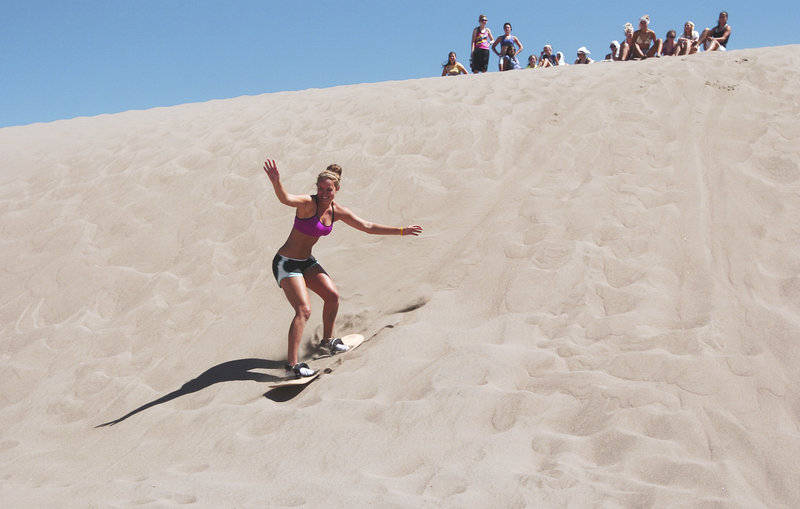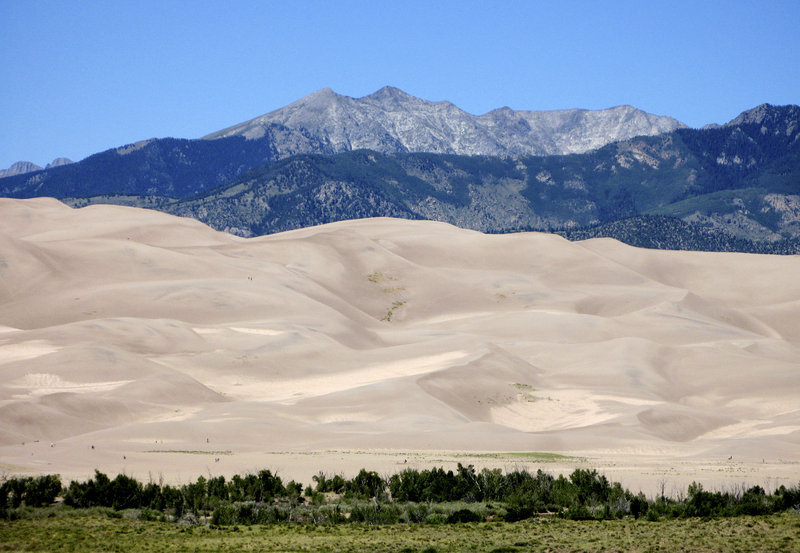MOSCA, Colo. – Driving up to Great Sand Dunes National Park and Preserve, the view seems almost silly: Across from shallow creeks at the base of the 14,000-foot Sangre de Cristo Mountains sit the largest sand piles in North America, kept in place by wind and water.
Melting snow, mountain creeks and storms regularly flush sand down the western side of the mountains, and southwesterly winds push the sand back on itself.
It’s a cycle that has created dunes up to 750 feet high, with sweeping views of mountains and sky.
Camping overnight at the park allows for unique views in moonlight, sunrise and sunset, but it’s also possible to squeeze in a day trip from Denver or Santa Fe, N.M.
A water bottle or two, some sunscreen and a little planning is all you need for a hike up the sand. But first some tips.
Park officials aren’t kidding when they say the high-altitude dunes get piping hot in summer, even though temperatures usually don’t get much above the mid-80s. The sand can reach 140 degrees, so it’s best to hike it in sneakers or closed shoes, either early in the morning or in the evening.
Sandals and flip-flops do come in handy for one thing though: In spring and early summer, melting mountain snow replenishes Medano and Sand creeks, which snake around the dunes. It’s refreshing to wade barefoot or in sandals in the water before and after a hike. In springtime, some kids in swimsuits and armed with sand shovels end up playing on this temporary beach without ever hiking up.
The creeks are largely gone by August, but a nearby mountain waterfall offers a welcome cool-down. More on that later.
The park has alpine and forest trails, but one of the simpler sand hikes is up High Dune. Fill up water bottles at the visitors center and head to the next parking lot. There are no trails on the dunes. Any route is possible.
Following the ridges is the best bet to avoid heading downhill too much before getting to the peak and having to hike back uphill in sand that swallows footsteps.
The Oasis shop right outside the park’s main entrance rents boards for around $20 a day so you can slide down the dunes like a snowboarder, although some people choose to ride them like a sled.
Jackie McCuistion, 19, of Alamosa, Colo., strapped into one shoeless and tried it out with friends. “Bend your knees, lean back and then just have fun,” she said after sliding down a ridge. Plastic sleds work too.
Plan on about 90 minutes to get to the top of High Dune, with breaks for photos and to catch your breath.
Afterward, head a few miles south of the park to Zapata Falls. Brown road signs point the way to a gravel road that winds three miles uphill to the start of a half-mile hike to the falls.
The water is usually icy cold in May, more tolerable in late summer. If you don’t mind getting your shoes wet, you can step into the shallow water to climb up a shelf back to a nook, right into a rocky hollow where you can watch the waterfall tumbling down from a mountain ledge and spattering you with a mist — a satisfying end to a day in the sun.
Send questions/comments to the editors.




Success. Please wait for the page to reload. If the page does not reload within 5 seconds, please refresh the page.
Enter your email and password to access comments.
Hi, to comment on stories you must . This profile is in addition to your subscription and website login.
Already have a commenting profile? .
Invalid username/password.
Please check your email to confirm and complete your registration.
Only subscribers are eligible to post comments. Please subscribe or login first for digital access. Here’s why.
Use the form below to reset your password. When you've submitted your account email, we will send an email with a reset code.